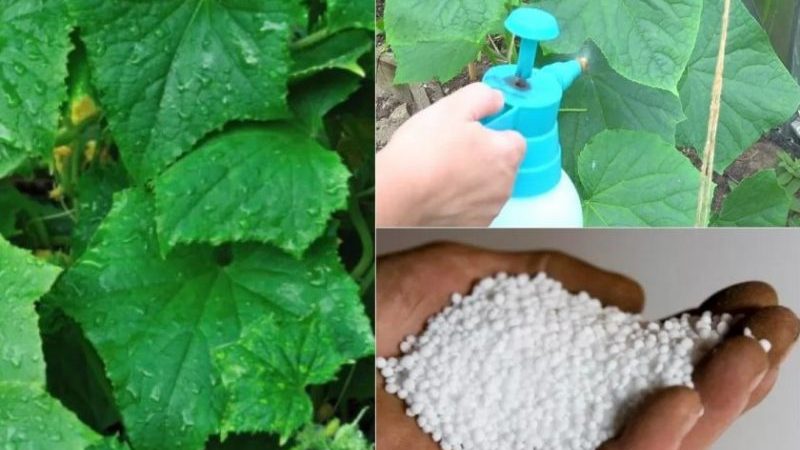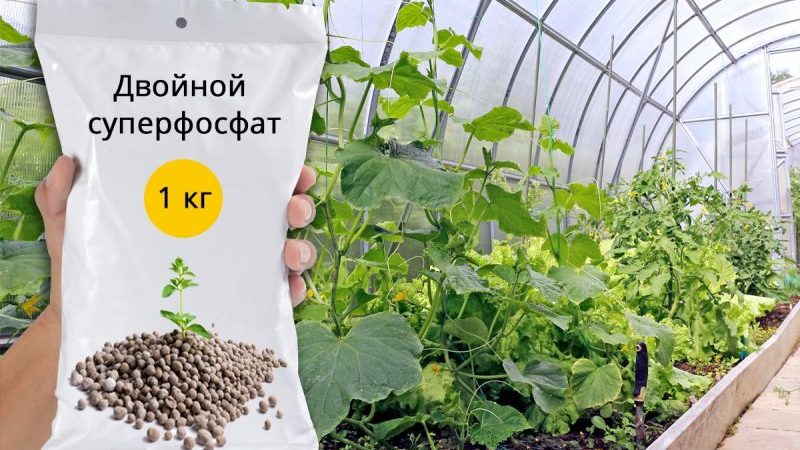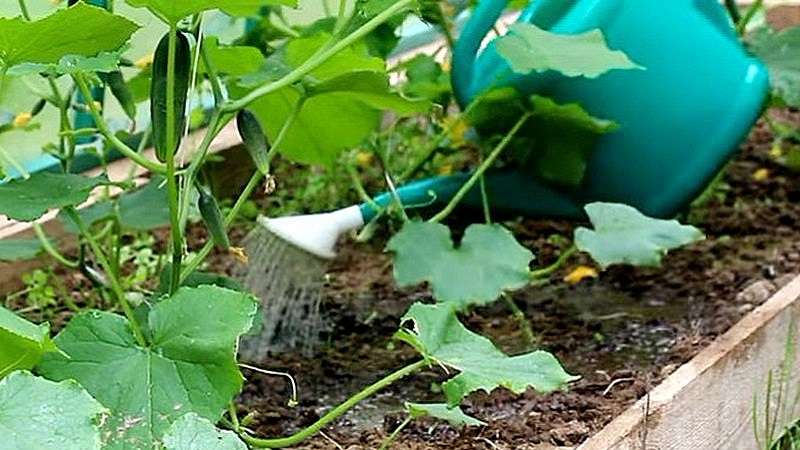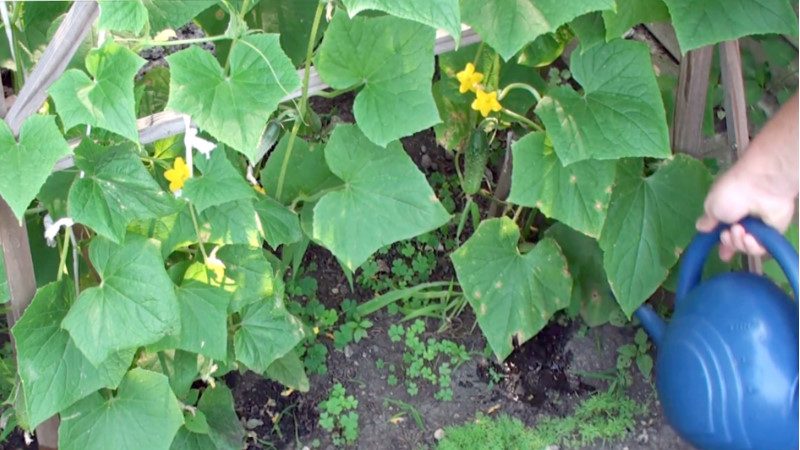The use of superphosphate for fertilizing cucumbers in the garden and in the greenhouse
Cucumbers are unpretentious in maintenance and undemanding to the type of soil, but on soils rich in organic matter and minerals, they give a higher yield. Fertilizing this culture begins with the emergence of seedlings and ends 2 weeks before harvesting vegetables. Among the wide variety of mineral dressings, one of the most popular options is superphosphate.
The content of the article
What is superphosphate
Superphosphate is a complex nitrogen-phosphorus sulfur-containing fertilizer... The chemical formula of simple superphosphate is Ca (H2PO4) 2 * H2O + 2CaSO4 * 2H2O. It is obtained from phosphorites treated with sulfuric acid.
The main component in the composition is phosphorus in an easily assimilable form for plants. The fertilizer is commercially available in the form of powder or granules.
Why do cucumbers need
At each stage of development, plants need certain substances. Such a macroelement as phosphorus is vital for cucumbers: it provides energy processes in the plant cell system, is responsible for metabolism, strengthens and stimulates the growth of the root system, accelerates the onset of flowering and fruiting, helps to increase productivity.
Varieties of superphosphate

There are two types of superphosphate, which differ in composition, appearance and purpose.
Plain
The agrochemical is sold in the form of a gray powder or granules. To obtain finely ground apatite or phosphorite, it is treated with sulfuric acid. Almost all phosphoric acid is well absorbed by the culture.
Composition:
- phosphorus (23-30%);
- calcium (17%);
- sulfur (8-10%);
- magnesium (0.5%);
- nitrogen (6%);
- gypsum and impurities (silica, aluminum and iron phosphates, fluorine compounds).
The advantages of this fertilizer are low price, faster dissolution in soil (in powder form). At the same time, the product contains almost half of unnecessary impurities: for example, gypsum in simple superphosphate up to 40%.
The agent is used in the industrial cultivation of cucumbers, to increase the fertility of compost, green manure and the cultivation of poor soils.
Double

Unlike simple, it contains twice as much phosphorus in the form of calcium monophosphate. Formula: Ca (H2PO4) 2 * H2O. To obtain phosphorite, it is treated with phosphoric acid formed from phosphorite or apatite and sulfuric acid.
Mix composition:
- phosphorus (45–48%);
- nitrogen (15%);
- sulfur (8-10%);
- magnesium (0.5%).
Fertilizer is sold only in granular form. It is more expensive than a simple one, but the price pays off with a number of advantages: the product is convenient to use, does not contain impurities and does not cake during storage.
It is used as the main fertilizer during flowering and fruiting cucumbers, for the cultivation of neutral and alkaline soil types. At the same time, on acidic soils, the agent is transformed into phosphates of aluminum and iron that are inaccessible to plants.
Granulated
This form of fertilizer is prepared from monophosphate (simple superphosphate). Raw materials in production are slightly moistened, pressed and rolled into granules. The amount of phosphorus reaches 50%, calcium sulfate - up to 30%.
The product dissolves slowly in soil and water, therefore it lasts longer. The effect after adding superphosphate lasts for several months.
Application:
- main application to the soil for plowing;
- foliar dressing;
- adding on landing;
- for the cultivation of the soil in the greenhouse;
- over large areas.
Fertilizer is poorly fixed in soil layers, so it is also used on acidic soils, pre-mixing with chalk.
Ammoniated
A special type of superphosphate for acidic soils. When it is introduced, the acidity of the earth does not increase, since the reaction is neutralized by ammonia.
Fertilizer composition:
- phosphorus (14–20%);
- calcium sulfate (up to 55%);
- sulfur (12%);
- nitrogen (10%).
Important! Superphosphate of any kind is not mixed with urea, sodium, ammonium and calcium nitrate, potassium carbonate.
Ammonized fertilizer gives cucumbers the nutrients they need to increase their resistance to fungal diseases and stress.
Dosage for cucumbers

Before using fertilizer, be sure to check the acidity of the soil. A granular agrochemical is applied immediately before irrigation. Dosages differ depending on the type of fertilizer and type of soil:
- The dry agent is added at the rate of 40-50 g per 1 m2. Double superphosphate is added 20-30 g per 1 m2. On depleted soils, the dosage is doubled.
- As a one-time feeding, take 5-10 g per plant.
- To prepare a working solution, 150 ml of the concentrated solution is diluted in a bucket of water.
How to dilute for feeding
To prepare a concentrated solution, take 20 tbsp. l. substances, dissolve them in 3 liters of hot water. The agent is stirred periodically until all the granules are dissolved. The process takes 12-15 hours.
Terms of top dressing
Fertilize cucumbers with superphosphate 2-3 times per season:
- In the fall, when digging up the soil and preparing the beds for cucumbers. Since the mixture dissolves slowly, it is used no more than 1 time in 2 years.
- In the spring, when sowing or picking seedlings. The substance is introduced into the wells or rows.
- Before flowering. This feeding is important and is responsible for the productivity of the crop. As soon as the first buds appear on the plants, they are fertilized with a superphosphate solution.
Instructions
Depending on the cultivation conditions for cucumbers, some of the nuances of using nitrogen-phosphorus fertilizers are observed.
In the greenhouse
In order for greenhouse cucumbers to grow healthy and give a good harvest, they need only 3 additional feeding with superphosphate:
- When replacing soil or preparing ridges in autumn. Add 40-50 g of a simple product per 1 m2 or 10-20 g of double. The agrochemical is evenly scattered over the ridges and harrowed with a rake, slightly embedding it in the soil.
- Foliar spraying of cucumbers during budding with working solution. It is carried out after 14 days.
In protected ground conditions, double superphosphate is preferred. The high content of impurities in the simple has a toxic effect on plants with high air humidity and a small greenhouse area.
Outdoors
Features of dressing in the open field differ little from greenhouse ones. On poor soils, the amount of superphosphate is increased. When adding the agent during sowing, compost and ash are additionally used so that the young roots are in direct contact with the fertilizer.
Important! If dry necrotic spots of small size appear on the lower leaves of cucumbers, this means that the culture lacks phosphorus. Such plants lag behind in growth, shed some of the ovaries and begin to bear fruit later than others.
For making liquid feeding a working solution is prepared in advance, it is used only after watering with plain water.
Application during fruiting
During the flowering period, the bushes are sprayed with a solution prepared from 35 g of superphosphate and 10 liters of water. The agent is kept for a day, mixed and filtered from the remainder of undissolved granules.
Landings are processed in the morning or evening hours. In the latter case, the time is chosen before 19:00 so that the cucumber leaves have time to dry before night. Otherwise, on wet bushes when exposed to cool temperatures will appear fungal diseases.
Precautions

Superphosphate belongs to hazard class 3, so gloves are used when working with dry or liquid products. For foliar dressing, windless days are chosen. During work, it is forbidden to talk, smoke, drink or eat food. After the measures taken, hands, face and other exposed areas of the body are thoroughly washed with soap.
Attention! Superphosphate is stored at a humidity of no more than 50% and a temperature of no higher than + 30 ° C in places inaccessible to children and animals.
In case of contact with the eyes, rinse them immediately with clean water. If after this there is a burning sensation or discomfort, consult a doctor.
Reviews
Basically, vegetable growers respond positively to the use of such fertilizer for cucumbers. Farmers prefer double superphosphate, note its ease of use, efficiency, but complain about poor solubility in water:
Lyudmila, Chelyabinsk: “I have been using double superphosphate for many years. It helps plants to set fruit faster, makes the roots more powerful and the bushes stronger. I pour dry granules under the cucumbers, slightly mixed with humus, add the agent to the grooves during sowing. The result is that the culture develops better, and a rich harvest is provided. "
Konstantin, Rostov-on-Don: “No matter how hard you try, in our time when growing vegetable crops you cannot do without fertilizers, especially if there is nowhere to get organic matter. For example, I live in the suburbs. No one sells humus or manure next to me. Therefore, I buy mineral fertilizers on the market. I choose superphosphate with a double phosphorus content. Fertilizer is less consumed and easy to use (not powder, but granules). I put in cucumbers 2 times: in the fall, when digging, and before flowering. "
Maria, Stavropol: “I grow cucumbers in a greenhouse. I get a lot of them, I sell the surplus on the market. To increase the quality and quantity of the cropI use superphosphate fertilizer in the garden for cucumbers. At first I bought a simple product, but then I read that it contains a lot of impurities and switched to feeding with a double phosphorus content. The only drawback is poor solubility. I dilute, as in the instructions, in hot water, but the granules do not completely disappear. And they are slowly consumed in the soil. In the spring, when loosening, I find their remains. "
Conclusion
For the health of cucumbers and a high yield of the harvest, it is important to fertilize them with phosphorus in an easily accessible form. Superphosphate perfectly copes with this task, additionally providing the culture with nitrogen, calcium, sulfur and other useful substances.
When using fertilizer, determine in advance the type and acidity of the soil. Mineral dressings are effective only if the instructions are strictly followed.